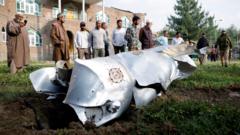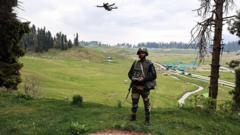**Amid ongoing hostilities, experts speculate on the possibility of escalation and the role of diplomacy in managing the crisis.**
**Escalating Tensions: The Aftermath of India's Air Strikes on Pakistan**

**Escalating Tensions: The Aftermath of India's Air Strikes on Pakistan**
**Indian air strikes heighten geopolitical tensions as both countries brace for potential retaliation.**
In a significant escalation of military tensions, India launched targeted air strikes against nine sites throughout Pakistan and Pakistan-administered Kashmir, claiming to target militant positions using "credible intelligence." The strikes occurred over a short span of 25 minutes early Tuesday morning, creating rumbles that awoke residents and heightened alarms in the region. In response, the Pakistani military asserted that it shot down five Indian fighter jets and one drone, a claim that India has not confirmed. The aftermath of India's action left Pakistan reporting 26 deaths and 46 injuries from the strikes and subsequent shelling along the Line of Control (LoC), while India reports civil casualties caused by Pakistani fire.
This military confrontation arises in the wake of a recent deadly militant attack in the Indian province of Jammu and Kashmir that claimed the lives of several tourists. India linked this assault to militants operating from Pakistan, a charge flatly denied by Islamabad, which demanded substantive evidence from India. This new set of air strikes reflects a significant shift in India's approach, broadening its targets to include key infrastructures belonging to major militant organizations.
Experts note that the scale and precision of India's attacks differentiate this incident from previous ones, such as the Balakot strikes of 2019, which were less comprehensive. According to analysts, this strategy conveys a strong deterrence message against groups like Lashkar-e-Taiba (LeT) and Jaish-e-Mohammed, signaling India’s intent to target terrorist networks operating from Pakistan rather than solely engaging in conflict along the LoC.
The prospect of deepening conflict looms as international observers suggest that retaliatory measures from Pakistan are likely. Experts anticipate a response that reflects military resolve but also bear the risks of escalation, potentially leading to a wider confrontation. Observers stress the imperative of crisis diplomacy in managing this situation and preventing it from spiraling into a significant military engagement.
Inside Pakistan, public sentiment appears more reserved compared to previous encounters, potentially leading to different dynamics for the military's response. However, if nationalist sentiments rise, there could be increased pressure on the military to take action against Indian targets. The unfolding situation tests the limits of political and military strategies on both sides and highlights the precarious balance between aggression and diplomacy.
As military operations ramp up, both India and Pakistan find themselves navigating a delicate pathway fraught with danger, where miscalculations could easily lead to broader conflict. The historical context of past escalations provides a sobering lens through which analysts view current developments, emphasizing the urgent need for diplomatic engagement to prevent a recurrence of past crises.
This military confrontation arises in the wake of a recent deadly militant attack in the Indian province of Jammu and Kashmir that claimed the lives of several tourists. India linked this assault to militants operating from Pakistan, a charge flatly denied by Islamabad, which demanded substantive evidence from India. This new set of air strikes reflects a significant shift in India's approach, broadening its targets to include key infrastructures belonging to major militant organizations.
Experts note that the scale and precision of India's attacks differentiate this incident from previous ones, such as the Balakot strikes of 2019, which were less comprehensive. According to analysts, this strategy conveys a strong deterrence message against groups like Lashkar-e-Taiba (LeT) and Jaish-e-Mohammed, signaling India’s intent to target terrorist networks operating from Pakistan rather than solely engaging in conflict along the LoC.
The prospect of deepening conflict looms as international observers suggest that retaliatory measures from Pakistan are likely. Experts anticipate a response that reflects military resolve but also bear the risks of escalation, potentially leading to a wider confrontation. Observers stress the imperative of crisis diplomacy in managing this situation and preventing it from spiraling into a significant military engagement.
Inside Pakistan, public sentiment appears more reserved compared to previous encounters, potentially leading to different dynamics for the military's response. However, if nationalist sentiments rise, there could be increased pressure on the military to take action against Indian targets. The unfolding situation tests the limits of political and military strategies on both sides and highlights the precarious balance between aggression and diplomacy.
As military operations ramp up, both India and Pakistan find themselves navigating a delicate pathway fraught with danger, where miscalculations could easily lead to broader conflict. The historical context of past escalations provides a sobering lens through which analysts view current developments, emphasizing the urgent need for diplomatic engagement to prevent a recurrence of past crises.


















